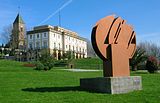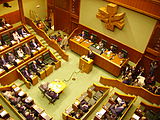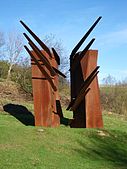| Revision as of 18:31, 26 May 2018 editBallenaBlanca (talk | contribs)Extended confirmed users6,901 edits Adjusted nationality as per Misplaced Pages:Manual of Style/Biographies#Context. The Constitution of Spain only admits one nation, which is the Spanish Nation.← Previous edit | Revision as of 21:15, 27 May 2018 edit undoIñaki LL (talk | contribs)Extended confirmed users11,820 edits Undid revision 843078112 by BallenaBlanca (talk) Rv systematic controversial editingTag: UndoNext edit → | ||
| Line 15: | Line 15: | ||
| }} | }} | ||
| '''Nestor Basterretxea Arzadun''' (6 May 1924 – 12 July 2014) was a ] artist, born in ], ], ].<ref>{{cite web | url = http://www.euskomedia.org/aunamendi/11973 | title = Nestor Basterretxea Arzadun | last1= Estornez Zubizarreta|first1= Idoia | last2= Izaga Sagardia|first2= Carmen |publisher = EuskoMedia Fundazioa | accessdate = 14 May 2014}}</ref> In the 1950s and '60s, he spearheaded along with other artists such as ], Remigio Mendiburu, or ], an avant-garde artistic movement concerned with the crisis of Basque identity, and formally a special focus on large volumes and the concept of emptiness. | '''Nestor Basterretxea Arzadun''' (6 May 1924 – 12 July 2014) was a ] artist, born in ], ].<ref>{{cite web | url = http://www.euskomedia.org/aunamendi/11973 | title = Nestor Basterretxea Arzadun | last1= Estornez Zubizarreta|first1= Idoia | last2= Izaga Sagardia|first2= Carmen |publisher = EuskoMedia Fundazioa | accessdate = 14 May 2014}}</ref> In the 1950s and '60s, he spearheaded along with other artists such as ], Remigio Mendiburu, or ], an avant-garde artistic movement concerned with the crisis of Basque identity, and formally a special focus on large volumes and the concept of emptiness. | ||
| ==Career== | ==Career== | ||
Revision as of 21:15, 27 May 2018
| Nestor Basterretxea | |
|---|---|
 | |
| Born | Nestor Basterretxea Arzadun (1924-05-06)6 May 1924 Bermeo, Basque Country |
| Died | 12 July 2014(2014-07-12) (aged 90) Hondarribia, Gipuzkoa, Basque Country |
| Nationality | Spanish |
| Occupation(s) | Sculptor, Painter, Film producer |
Nestor Basterretxea Arzadun (6 May 1924 – 12 July 2014) was a Basque artist, born in Bermeo, Biscay. In the 1950s and '60s, he spearheaded along with other artists such as Jorge Oteiza, Remigio Mendiburu, or Eduardo Chillida, an avant-garde artistic movement concerned with the crisis of Basque identity, and formally a special focus on large volumes and the concept of emptiness.
Career
In the 1952 Basterretxea was commissioned along with other Basque artists the reconstruction of the Franciscan Sanctuary of Arantzazu. He was assigned the works to design the paintings covering the crypt. After a year-long period and halfway to completion, the paintings were held to be controversial by Church officials and works were suspended sine die. Despite their completion in 1984, the paintings were publicly unveiled and put on show only in September 2009, after an agreement was finally reached with the veteran artist. The Arantzazu reconstruction project paved the way to the establishment of the influential artistic group Gaur ('today') in the 1960s.
In 1973, he presented in Bilbao's Museo de Bellas Artes (Bilbao Fine Arts Museum) his work Serie Cosmogonica Vasca (Basque Cosmogonic Series), which included some 19 works made in wood depicting Basque Mythology motifs. In 2008, Nestor donated this series to the Bilbao Fine Arts Museum.
In the 1980s Basterretxea became Culture Councillor for the Basque Government for two years. In 1982, he created the seven branched tree that heads the Basque Parliament. Towards the end of that decade, he created two of his best known works: La Paloma de Paz (Peace Dove), initially installed at the Zurriola seafront, Donostia (San Sebastian), later on moved to a roundabout outside the Anoeta Stadium of the same city, and back to the same location somewhat later. In 1989, the Memorial to the Basque Shepherd was installed in Reno, Nevada. When Basterretxea entered his seventh decade of life, he started to reflect the Basque conflict in his work.
Basterretxea also engaged in film making, with short films such as Operación H (1963), Pelotari (1964), as well as Alquézar, retablo de pasión (1965), as well as several other documentaries. In 1968, he came back onto the spotlight with the full feature documentary Ama Lur - Tierra Madre ('mother earth'), co-directed with Fernando Larruquert. Despite the documentary's countless difficulties with Franco's regime's censorship, it ultimately made it through to the San Sebastián International Film Festival, to public and critical acclaim.
Basterretxea died at his home in Hondarribia in the morning of 12 July 2014, at the age of 90.
Gallery
Some sculptures by Nestor Basterretxea-
Curled sculpture depicting a wave in Bermeo
-
 Leioako indarra next to a church (Biscay)
Leioako indarra next to a church (Biscay)
-
 Sculpture perched on the front of the dam of Arriaran (Gipuzkoa)
Sculpture perched on the front of the dam of Arriaran (Gipuzkoa)
-
 Depiction of a tree with seven branches presiding over the Basque Parliament
Depiction of a tree with seven branches presiding over the Basque Parliament
- Memorial to the Basque sheepherders in the outskirts of Reno, Nevada Memorial to the Basque sheepherders in the outskirts of Reno, Nevada
-
 Lurraren alde of the Basque sculptors Park "Meatzaldea Goikoa" in La Arboleda-Zugaztieta.
Lurraren alde of the Basque sculptors Park "Meatzaldea Goikoa" in La Arboleda-Zugaztieta.
References
- Estornez Zubizarreta, Idoia; Izaga Sagardia, Carmen. "Nestor Basterretxea Arzadun". EuskoMedia Fundazioa. Retrieved 14 May 2014.
- Gonzalez, Marian (2009-11-09). "Remodelación de los murales de la Cripta de Aranzazu". El Diario Vasco. Vocento. Retrieved 14 May 2014.
- ^ eitb.com. "Basterretxea, figura de la modernidad artistica reivindicativa". Retrieved 12 July 2014.
- Roldán Larreta, Carlos. "Ama Lur". EuskoMedia Fundazioa. Retrieved 14 May 2014.
- eitb.com. "Muere el escultor Nestor Basterretxea a los 90 años". Retrieved 12 July 2014.